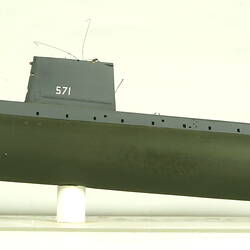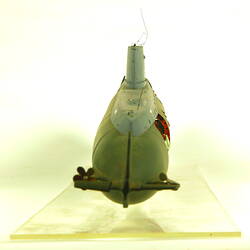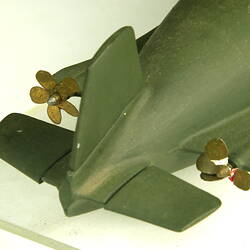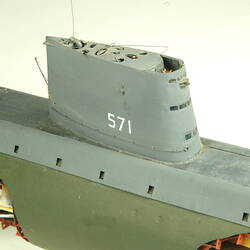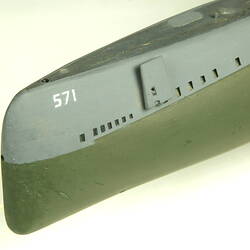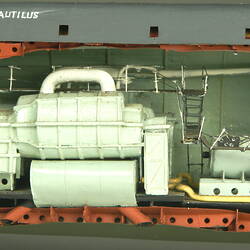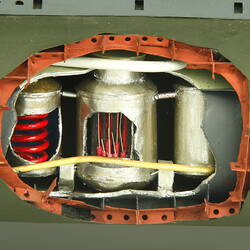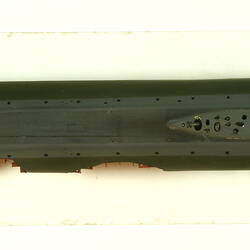Summary
'Cutaway' scale model of the world's first nuclear-powered submarine USS Nautilus (SSN-571), built for the United States Navy in 1952-1954. The model is believed to have been built by Ron Sherlock, of Malvern East, Victoria, from whom it was purchased by the Museum in September 1960. Scale 1:128
The vessel was named after Captain Nemo's fictional submarine in the 1870 classic science fiction novel 'Twenty Thousand Leagues Under the Sea', by author Jules Verne. It was also named in honour of the earlier conventionally powered submarine USS Nautilus (SS-168) that had served with distinction during World War II. Construction of the 'atomic powered' Nautilus was authorized in 1951, with the keel laid down by General Dynamics' Electric Boat Division in Groton, Connecticut on 14 June 1952. It was developed by a project team led by Admiral Hyman Rickover, USN. The vessel was launched into the Thames River on 21 January 1954, after being christened by the wife of President Eisenhower. The Nautilus was commissioned on 30 September 1954, but spent another 3 months dockside undergoing final fitout and testing. On the morning of 17 January 1955, at 11 am EST, the Nautilus entered service, putting to sea for the first time as Commander Eugene P. Wilkinson, USN, signalled his historic message "Underway On Nuclear Power."
Because the vessel's nuclear propulsion allowed her to remain submerged far longer than previous diesel-electric powered submarines, the Nautilus broke many records for endurance and speed during her early years of operation, and travelled to locations previously beyond the limits of conventional submarines. In 1958 USS Nautilus completed the first voyage under the North Pole. This fulfilled the vision of Australian explorer Sir Hubert Wilkins, who had attempted to travel beneath the ice to the North Pole in 1931 using a converted US Navy O-class submarine he named 'Nautilus'.
The USS Nautilus was decommissioned in 1980 and designated a National Historic Landmark in 1982. The submarine has been preserved as a museum in Groton, Connecticut, where it is open to the public.
Physical Description
Three sectioned 'cutaways' in the submarine's hull reveal internal details of the engine room & steam turbines (for propulsion), nuclear reactor and torpedo tubes & armaments store. Dimensions of Vessel Depicted: Length: 300 feet ( Tonnage: 3,200 Displacement: 3,533 tons surface; 4,092 tons submerged Length: 3,20 ft (98 m) Beam: 28 ft (8.5 m) Draft: 26 ft (7.9 m) Installed Power: 13,400 h.p. (10,000 kW) Propulsion: STR nuclear reactor; geared steam turbines; two propeller shafts Cruising Speed: 23 knots (43 km/hr; 26 m.p.h.) Crew: 13 officers, 92 enlisted Armament: 6 torpedo tubes
More Information
-
Collecting Areas
-
Acquisition Information
Purchase
-
Modelmaker (Probable)
Mr Ron Sherlock, Malvern East, Greater Melbourne, Victoria, Australia, circa 1960
The model was purchased from Ron Sherlock who is believed to have also custom built it. -
Classification
-
Category
-
Discipline
-
Type of item
-
Model Scale
1:128
-
References
'USS Nautilus (SSN-571)', In Wikipedia, The Free Encyclopedia, viewed 11 January 2018, [Link 1](SSN-571)&oldid=819261997
-
Keywords
Naval Vessels, Nuclear Power, Nuclear Reactors, Nuclear Technology, Submarines


